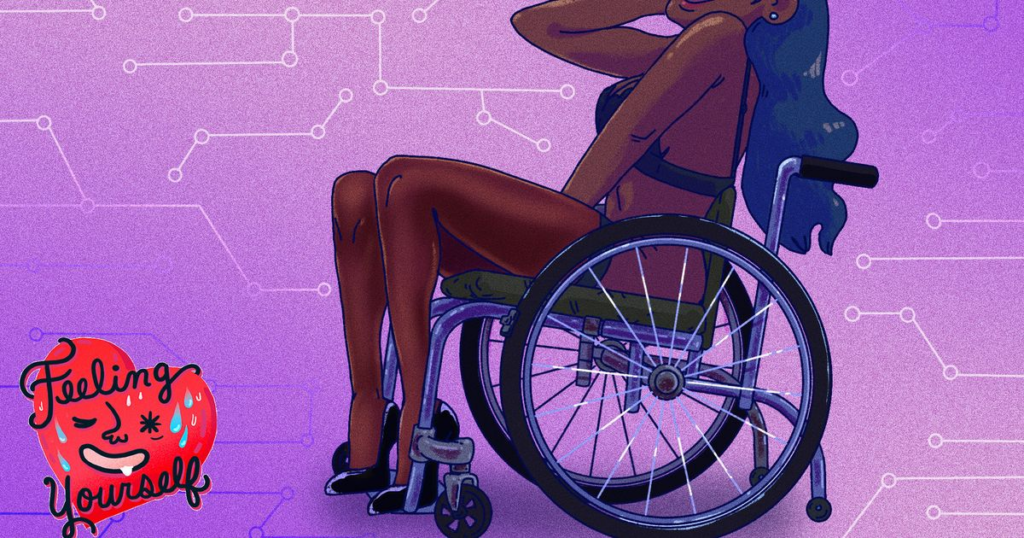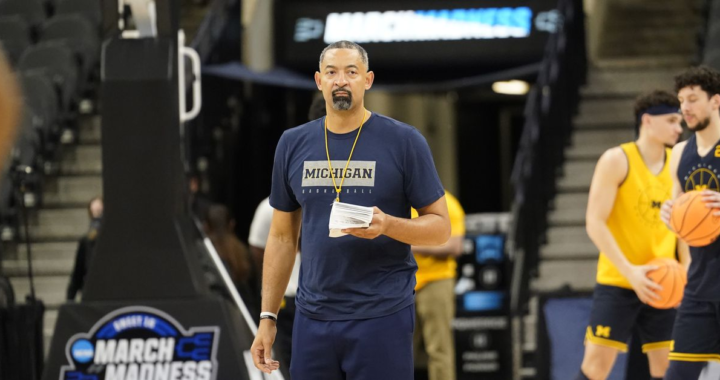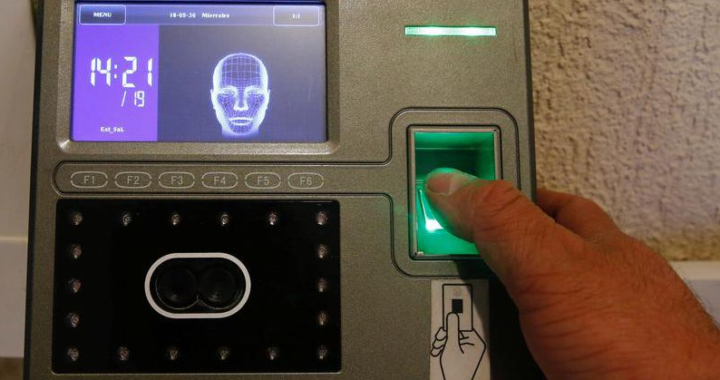This company wants to make sex toys more accessible for people with disabilities
1 min read
Sextech is bringing a much-needed cultural shift in how we view, talk about, and sell sex. Ushered in by a wave of women-led startups combining sex and technology to disrupt historically male-dominated sectors, this burgeoning multibillion-dollar industry champions inclusivity through innovative sex products created for and by more marginalized perspectives, bodies, and identities.
Yet while everything from high-tech sex toys to online sex education platforms are more inclusive than ever, a huge and diverse population remains excluded from this sextech revolution that’s supposedly promoting pleasure for all: people with disabilities.
But Handi aims to change that.
Helmed by brother and sister Andrew Gurza and Heather Morrison, Handi is the first sextech company to create a line of toys specifically designed for and by people with physical disabilities.
“We’re making sure that every facet of what we do has a disability lens to it.”
“Most companies put in disability as an afterthought, just to say, ‘Oh, yeah, we’re totally inclusive, we recognize disabled people,'” said Gurza, a sex and disability awareness consultant who calls himself Handi’s Chief Disability Officer. “But we’re making sure that every facet of what we do has a disability lens to it.”
Morrison agreed, telling Mashable that despite “more brands wanting to be seen as inclusive and doing something for people with disabilities, very few dedicate the proper money or resources needed to fix the problem, or to design innovative solutions.”
While their flagship Handi Joystick only just entered the prototyping phase in November 2020, it’s set for presale in August, and then for market launch by the end of the year. The sibling co-founders have spent years working on concepts to help bridge this glaring gap in the sex toy market by working in partnership with a research and design team from RMIT University in Melbourne, Australia.
“We quickly learned that we wouldn’t be able to create just one single toy that works for everybody,” said Morrison. But after multiple surveys and research from RMIT, they concluded that one of the most common physical barriers to masturbation were hand-related disabilities and limitations, ranging from lack of reach, dexterity, weakness, and chronic illnesses like arthritis. But even creating a product that could address that was no small task. “Disabilities have such a massive range, even within just hand barriers.”
The dream of creating a toy that’d let people with physical disabilities masturbate unaided by caregivers began several years prior. In 2017, while watching the Picture This Documentary her brother had starred in, Morrison learned he’d lost the ability to masturbate as he got older, due to the worsening spasticity of his hands.
She was shocked to discover that products to help him and others masturbate didn’t already exist. So Gurza suggested (rather naively, he said in retrospect), “Well, then let’s make one.”
Morrison described this essential (albeit kinda awkward) conversation about her sibling’s sexual health as a “lightning bulb moment.” Like so many others who haven’t yet lived with a disability, she’d simply never even thought to consider what an enormous problem lack of access to self-pleasure posed for some people with disabilities.
A widespread lack of awareness around the sexual needs of folks with disabilities, she soon realized, was at the heart of what they needed to tackle with Handi.
“What we learned really early on was that you can’t design and work on a product like this without also having these larger conversations around disability and sex. The two are so intricately linked because it’s still such a taboo. There’s so much education needed in mainstream society,” Morrison said.
Sexuality is, by itself, already a taboo. But people with disabilities often face a litany of additional ableist stigmas and misconceptions about their sexuality. The fact that family members are often primary caregivers only contributes to the silence. Meanwhile occupational therapists who assist with every other area of living (like going to the bathroom) are not usually trained to treat sexual health, since it’s not often seen as essential to a patient’s overall well-being.
“Often society and even their own communities teach people from a young age, ‘You’re disabled and therefore, you don’t have sexual needs or your sexual needs are wrong.’ And when those conversations aren’t normalized, it only increases feelings of alienation and shame,” said Morrison. “We want to give more and more people that light bulb moment, drive awareness to the fact that there’s a problem, but also help people who are living with these experiences every single day by opening up conversations that tear down those taboos.”
The World Health Organization (WHO) already defines sexual health as nothing short of a human right everyone deserves access to. The WHO also estimates that 15 percent of the population (roughly a billion people) live with disabilities, making them one of the largest minorities. So while pleasure and disability might rarely be discussed, that doesn’t mean lack of access doesn’t have sweeping, severe, and negative impacts on a large segment of the population.
Scientific research that captures the full scope of the issues around sex and disability remains scarce. But in the many surveys conducted by Handi (though they had a somewhat limited sample size), roughly 56 percent of people with physical disabilities reported having difficulty with self-pleasuring.

“There’s so little representation of disabled bodies experiencing pleasure on TV, movies, in porn, whatever. Disabled people aren’t given the chance to even imagine what it looks like,” said Gurza. “It does us a disservice. Because we go out into the world as fully formed adults and go, I don’t know how to do this, there’s no resources, and nothing I see reflects my point of view.”
After a year of pandemic isolation, many of us intimately understand exactly how essential masturbation can be to our mental and physical health. For folks with disabilities, though, access to self-pleasure can take on even greater significance.
“For me and a lot of disabled people I think, I’m always managing someone else’s schedule, on someone else’s timeframe — caregivers, doctors, family. I don’t get the time to even consider my own pleasure,” said Gurza. “Masturbation matters because it’s a moment for you to be in your body, be with yourself, have moments of enjoyment that don’t rely on anyone else… It really comes down to masturbation as a form of independence.”
What disability-driven sex toy design looks like
Despite these barriers around self-pleasure — from the physical to the interpersonal and societal — there’s never been more of an opportunity to address them. Sextech is, if nothing else, deeply invested (in every sense) in getting as many people as possible to cum as much as they’d like with their products.
“There’s a problem and gap here, but also there’s a massive amount of opportunity. Not just to help people, but opportunities for business, innovation, better design for everyone,” said Morrison.
Some high-tech toy companies like Dame and Lora DiCarlo, while not exclusively designed for people with disabilities, are already reaching out to take notes from Handi on how to make their innovations more accessible.
Michael Tepper, a sexuality educator, author, researcher, and counselor specializing in chronic illness and injuries, has been fighting the taboo around sex and disability for decades now. Over the years, he’s seen many promising products and resources come and go.
Some remain, like an old 2009 medical manual for adapting various toys, and medical devices like the Ferticare and Viberect male masturbators. The Perfect Pleasure Pillow, while low-tech, continues to be a staple in adaptive accessories for people with vulvas (also designed by someone with a disability herself). Otherwise, Venus — while extremely costly and lacking resources around disability-specific use — also offers customizable masturbators for penises and (mostly) hands-free dildo machines for vaginas.
“There’s a problem and gap here, but also there’s a massive amount of opportunity.”
But this new wave of affordable and inclusivity-driven sextech is unlike anything Tepper has seen in the past.
For one, there’s increasing mainstream awareness, with companies like Hot Octopus catering more to their longtime, sizable base of customers with disabilities through hubs dedicated to accessibility and seniors, and in 2019 spotlighting and hiring more bloggers with disabilities. There’s also finally more accessibility-driven toys for people with vulvas, with Dame’s Fin finger vibe (also one of my personal favorites) and more experimental but hands-free (kind of) Eva for couples being two of Tepper’s go-to recommendations.
I recently discovered the Pulse lube dispenser, too, which tackles inaccessibility by replacing the obstacle of opening finicky lube bottles with Keurig-like pods that automatically dispense when a hand is put under the censor.
On the representation front, Handi already teamed up with MakeLoveNotPorn (a social sex platform where users can upload sexy videos of themselves). CEO Cindy Gallop offered their community a 50 percent discount on their whole library back in August, hoping it might also encourage people with disabilities to contribute their own sexy videos (which the Handi blog has some tips for). Meanwhile Hollywood is ever so slowly catching up too, with a Grace & Frankie plotline finding the ladies on a journey to start their own vibrator company for folks with arthritis and aging-related hand difficulties, while Ryan O’Connell’s semi-autobiographical Special Netflix show tackles his personal experiences with sex and love as a gay man with cerebral palsy.
Yet still, very common, fundamental problems remain for people with disabilities trying to use toys that claim to be inclusive but were not designed with any direct input from those with the lived experiences of disability.
Rachel Wright, a content creator, speaker, and actress who starred in adult films, said one of the biggest barriers she experienced from Ehlers-Danlos Syndrome (which impacts connective tissues like joints) is the sheer lack of online resources and information. After scouring the web for disability-specific reviewers, finding none, then independently looking through 20-30 vibrators that never once mentioned anything about features better suited for limited mobility — she just gave up.
While there are now a few toy reviewers with disabilities like Cripping Up (from a consultant who goes by Eva and offers other resources), they remain hard to find. As Wright said, “It’s still a niche people need to actively look for, as opposed to a more generally inclusive societal shift that adds descriptions of features that consider people with disabilities.”
There’s also the very common experience of folks spending a minimum of $200 on a high-tech toy that works for one person’s disability, but may not for another’s. On top of the financial cost of sextech exploration (which can be especially burdensome for some folks with disabilities who rely on limited government assistance), there’s an emotional toll too.
“If a sex toy doesn’t work out for me, it can feel like there’s something wrong with my body, like my body is just too different,” said Wright. “That’s what’s kind of put me off exploring.”
To address this problem, Handi hopes to borrow one of the most lowkey disruptive innovations Dame contributed to the industry: a return policy. For decades, sex toys were labeled too “unsanitary” to return, but Dame called bullshit. In reality, the industry-wide standard was an easy cover for companies to sell toys with gimmicks they never bothered actually testing on people before putting them on the market, since you couldn’t ask for your money back if it sucked anyway.
While she wasn’t yet able to confirm exactly how, Morrison said they are committed to figuring out how to include this in Handi’s business model too.
“If a sex toy doesn’t work out for me, it can feel like there’s something wrong with my body, like my body is just too different.”
Another major issue both Wright and Tepper commonly encounter with sextech (which Dame also avoids) is awful, inaccessible button design. Even for people without disabilities like myself, this glaring flaw is a problem I’ve most egregiously encountered with the most luxury sextech brands of all, like Lelo.
“You’ve got to press quite firmly for like five seconds to turn it off, which can really hurt. That sounds pathetic, but like, my god, I shouldn’t be in pain after cumming. That’s ridiculous,” said Wright.
It isn’t pathetic. But it is an unbelievable oversight from alleged innovation leaders.
“With the newer technology, the buttons are so small I recommend people get toys that have phone apps. A lot of people with severe hand limitations already use adapted interfaces for their phones and computers. So they’re more easily able to control their own toy or even partner’s toy with the app,” said Tepper.
A word of caution from someone who has tried almost every Bluetooth-connected and app-enabled toy under the sun, though: They are often rife with their own infuriating connectivity issues. Budget-friendly company Satisfyer is a singular exception to the overall rule, though.
Gurza similarly recalled how his first experience with a toy sent over by a well-meaning sextech company was “one of the most embarrassing moments ever.” To start, he couldn’t open the packaging nor set it up on his own, requiring assistance from his caregiver. She (also well-meaning) obliged, but said she’d be back in just ten minutes to help clean up.
“I was just like, welp, that’s not very long. I felt really awkward. I can’t get into the zone when I’m on a timer, when I can’t do it myself. Then I ended up hurting myself and had to call her back in,” he said. “There was nothing sexy about it.”
What all these seemingly small but hugely limiting errors point to is the need for what Gurza calls “disability-driven sex toy design” in the industry.
Morrison explained how, “Through every single phase of research, we’ve always had a really cross-collaborative team of people at the table. But the end-user is always at the center, the heart of it. People with disabilities are represented at every stage, actively in the conversations rather than just people we talk about helping abstractly.”
Who wouldn’t want to fully hug their sex toy?

Handi gets feedback from a variety of testers with a range of hand-related disabilities to ensure that every part of the experience — from packaging to clean up to even storage — is as unassisted for as many people as possible.
They also include people responsible for caring and assisting people with disabilities, too. “We work directly with occupational therapists, since they see clients every day, have amazing brains for problem-solving, and see firsthand the most common issues.”
The most important takeaway they got from all the feedback on the Handi Joystick was the need, “to make this first toy design the most flexible and versatile for different needs, so we can help the most people, before turning to the next design in our range,” Morrison said.
They call the Joystick a product system because, “We’re designing accessible middle sections with vibrators and sleeves and big buttons that fit into the middle section of the Joystick. But we know that many people have bought sex toys that they thought would work and paid good money for but now currently sit in their drawers. So for those who can operate and work those toys’ controls and buttons but just need help holding it in place, we designed the midsection to act as a holster. So depending on the disability, people can buy the full system or just different parts of the system that work best for their needs.”
One of the most widespread mistakes sextech championing inclusivity makes is the impossible promise of a one-size-fits-all sex toy solution. When it comes to the human body, one-size-fits-all never applies. But not being considered whatsoever as part of the “all” that these toys are supposed fit can be especially insulting to people with disabilities.
“[People with disabilities] are as diverse as any population, even with just the range of sexual preferences and orientations. So we know we can’t promise one product that’s for everybody,” said Morrison. “But by this time next year we’re aiming to design a whole line of toys, accessories, and lingerie from that disability lens. We have big dreams for how to continue the sexual revolution from a disability point of view.”
But, of course, there isn’t just one singular, monolithic disability perspective. And unfortunately, Gurza said, the same discriminatory patterns we see crop up in non-disabled communities also crop up in communities of people with disabilities.
“The representation and conversations around disability are still super white, super male, super cis, and super focused on one type of disability, which is usually spinal cord injury,” said Gurza, who is a queer man himself. “We need more disabled people of color in these conversations. There’s so much that can be done to show the diversity within the community that I don’t think is happening in the media space.”
The future of sex and disability
Sextech’s failure to be more inclusive toward people with disabilities isn’t just a loss for those currently living with disabilities.
Mainstream society tends to view disability as an issue separate from the general population. In reality, whether through accidents, illnesses, or simply aging, a majority of people will experience some form of physical disability in their lifetime. Hundreds of thousands of people right now with long-haul Covid are slowly coming to realize that they themselves are now part of a chronic illness disability population.
“We have big dreams for how to continue the sexual revolution from a disability point of view.”
“Handi is orgasm insurance. It isn’t a completely selfless endeavor, or just about Andrew,” said Morrison. “It’s so that, when I get older, there are tools and products and an open conversation that means I can still continue to enjoy self-pleasure.”
Further, by ignoring people with disabilities, the industry is ignoring the opportunities of a huge, global, untapped market.
“Disabled people have spending power. They’ll spend their money on stuff that works for them. But nothing has been designed for them the ground up until now,” said Morrison. “That’s a huge barrier for them, but also for the industry.”
Sure enough, throughout their years-long quest to make sextech more accessible, Gurza and Morrison were struck by something I myself was shocked to discover after testing dozens of the most supposedly innovative high-tech toys.
“Outside a few exceptions, sex toy companies and manufacturers have mostly been able to get away with really low levels of innovation that still make bucket loads of money. But because we’re designing for a need and a barrier that’s not been addressed or designed for previously, it means having to actually innovate,” said Morrison. Disability-driven design has the potential to up the ante on innovation standards across the industry. “Hopefully, it encourages everyone to put in the time and effort into understanding the barriers that are actually happening for people, and to ideate on what designs will help overcome them. More universal design benefits us all.”
“We’re not hoping for tons of competition,” Gurza said, laughing. “But disability is so broad, there’s so many different toys that could be created. There’s so many different types of limitations innovators could tackle, so many other avenues that we could go down.”
The handiest siblings you’ll ever meet
Tepper, for one, is eager to see what might develop in the fields of virtual reality and robotics for people with disabilities.
“Orgasm research has identified the brain as a major mediator of sexual pleasure. So what if we could look into direct brain stimulation that bypasses the genitals altogether,” he said.
What might sound like science fiction is far closer to reality than you’d think. In 2018, a researcher from the University of São Paulo presented findings on the Neurodildo, a sex toy prototype remotely controlled by the wearer’s brain waves. Others are working on electrode spine implants that’d allow a person to orgasm at the touch of a button.
But in the immediate future, Tepper believes speculative tech serves people with disabilities less than simply broadening our concept of sexual pleasure beyond just climax from penis and vaginas.
“We need to increase our focus on self-pleasuring beyond stimulating the genitals. You can learn to orgasm through your nipples if you can’t reach your clit. With the right intention, focus, practice, you can become orgasmic through areas in reach. That’s not even technology. That’s just education.”
Certainly, technology can prove key in the much-needed spread of education around sex and disability. If you ask Gurza, though, there really are no limits on the potential here.
“This should be an industry that is bringing in billions. But unfortunately right now we’re just not talking about it enough. So hopefully in a few years, we’ll start bringing in those billions.”









